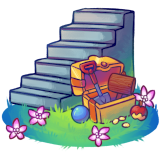Dungeon Floor: Difference between revisions
Created page with "{{Stub}} A '''Dungeon Floor''' is a single floor that is generated for a dungeon. Each floor has properties that determined how it is generated, this includes the tileset to use, the music to play and a list of Pokémon, items and traps to spawn. In SkyTemple you can edit the properties of a floor and show a preview of how a generated floor might look like in-game.{{NavSkyTemple}}" |
Plasma7007 (talk | contribs) Added details about structure settings |
||
| Line 1: | Line 1: | ||
{{Stub}} | {{Stub}} | ||
A '''Dungeon Floor''' is a single floor that is generated for a [[Dungeon Properties|dungeon]]. Each floor has properties that determined how it is generated, this includes the tileset to use, the music to play and a list of Pokémon, items and traps to spawn. In [[SkyTemple]] you can edit the properties of a floor and show a preview of how a generated floor might look like in-game.{{NavSkyTemple}} | A '''Dungeon Floor''' is a single floor that is generated for a [[Dungeon Properties|dungeon]]. Each floor has properties that determined how it is generated, this includes the tileset to use, the music to play and a list of Pokémon, items and traps to spawn. | ||
In [[SkyTemple]] you can edit the properties of a floor and show a preview of how a generated floor might look like in-game. The preview however can not show [[Fixed Room|Fixed Rooms]] and will display a note when a floor has a Fixed Room in use. | |||
== Layout == | |||
=== Structure: === | |||
This tab is used to change the general layout of floors. | |||
* <u>Structure Type</u> can be used to select the general layout of the floor. Several different structure types can be selected. Small, Small Medium, Medium, and Medium Large have the most random variation between floor shapes while Ring, Crossroads, Two Rooms One Monster House, Line, Cross, Beetle, and Outer Rooms have a more specific shape they tend to hold with lesser random variation. Single Monster House will always spawn a singular room as the entire floor with a Monster House. | |||
* <u>Floor Connectivity</u> changes the amount of connections between cells used to generate the floor map. | |||
* <u>Extra Hallway Density</u> is used to determine the amount of extra hallways on the floor once the initial connections are made. These can be extra connections between rooms, loops, or dead end hallways. | |||
* <u>Room Density</u> is used to determine the amount of rooms on a floor. Some random variation may be applied to this number and a floor will never have less than two rooms unless it is a whole floor monster house. | |||
* <u>Dead Ends</u> can be toggled on or off and determines if hallways can lead to dead ends instead of a room or other hallway. ''Note that dead ends can still occasionally spawn even with them turned off due to a bug in the game.'' | |||
{{NavSkyTemple}} | |||
Revision as of 03:08, 25 January 2024
This article is unfinished. You can help expanding it.
A Dungeon Floor is a single floor that is generated for a dungeon. Each floor has properties that determined how it is generated, this includes the tileset to use, the music to play and a list of Pokémon, items and traps to spawn.
In SkyTemple you can edit the properties of a floor and show a preview of how a generated floor might look like in-game. The preview however can not show Fixed Rooms and will display a note when a floor has a Fixed Room in use.
Layout
Structure:
This tab is used to change the general layout of floors.
- Structure Type can be used to select the general layout of the floor. Several different structure types can be selected. Small, Small Medium, Medium, and Medium Large have the most random variation between floor shapes while Ring, Crossroads, Two Rooms One Monster House, Line, Cross, Beetle, and Outer Rooms have a more specific shape they tend to hold with lesser random variation. Single Monster House will always spawn a singular room as the entire floor with a Monster House.
- Floor Connectivity changes the amount of connections between cells used to generate the floor map.
- Extra Hallway Density is used to determine the amount of extra hallways on the floor once the initial connections are made. These can be extra connections between rooms, loops, or dead end hallways.
- Room Density is used to determine the amount of rooms on a floor. Some random variation may be applied to this number and a floor will never have less than two rooms unless it is a whole floor monster house.
- Dead Ends can be toggled on or off and determines if hallways can lead to dead ends instead of a room or other hallway. Note that dead ends can still occasionally spawn even with them turned off due to a bug in the game.
